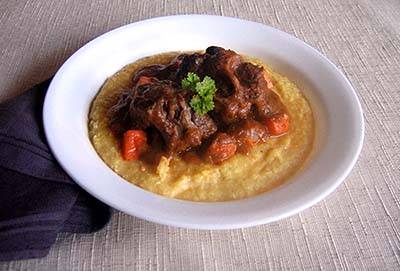
Though regarded as a staple of Italian cuisine, polenta was actually an American export. As they did with cars and other utilitarian goods, the Italians took humble American corn meal mush and made it into art, topping it with everything from braised veal shanks to poached eggs and truffles.
But not all Italians were taken with polenta. Those in the south ate it only when forced by poverty during WWII. From the 1700s until then, they referred to their northern brethren by the slight, “mangioni di polenta” (polenta eaters).
The cheapness of polenta makes it attractive if your wallet is thin, but dining on it exclusively can cause problems. Early on, polenta was so popular in northern Italy and its people so poor, that they ate little else and suffered from the niacin deficiency disease, pellagra. The same occurred in the decimated American south in the early 1900s.
Context is everything. In Central America, corn is first treated with lye or lime and then ground. The resulting flour and meal do not lead to nutritional deficiencies and can safely play a greater role in one’s diet. Because it shortcuts this process, polenta should be consumed with other proteins.
While much of the corn that grows around Central Illinois is not used for food, local polenta does exist. Moore Family Farm stone mills polenta and sells it through Common Ground Food Coop, as well as at the family’s stand at the Market at the Square in Urbana starting in May.
Whether coarse or finely ground, polenta is extremely versatile. You can make it into a thick porridge and simply top it with cheese. Or, you can make it thinner and use it in place of risotto, pasta, or mashed potatoes as a base for stews. If you are up for a little more effort, make a thick batch and pour it into a lightly greased, foil-lined baking pan. Spread it evenly and when cool, remove it from the pan and cut it into pieces. If you want, fry the pieces, or simply top them with sauce. Alternatively, you can grill or toast the pieces in an oven and use them in place of bread for starters. In summer, try topping them with fresh tomato, mozzarella, and basil; in winter, caramelized onions and blue cheese.
Despite its reputation, polenta does not have to involve constant stirring and babysitting. The always practical arbiter of Italian cuisine, Marcella Hazan, advises the following recipe to produce a good polenta with minimal effort in a reasonable amount of time. However, the difference between a good polenta and a great polenta is not just in the corn. Dairy is the key, advises Thad Morrow, chef/owner of bacaro in Champaign. He finishes Hazan’s recipe with two to three tablespoons of good, quality butter, and often, a generous amount of Mascarpone cheese.
Basic Creamy Polenta
- 4 cups water
- ¾ teaspoon salt
- 1 cup polenta
- 2 to 3 tablespoons good, quality butter
Bring water and salt to a boil in a heavy two-quart pot. Add one cup of polenta in a thin stream, whisking briskly. Cook over moderate heat, whisking for two minutes continuously. Reduce heat to low and simmer covered. Stir for one minute every 10 minutes of cooking time, for 30 minutes total. Stir in butter. Remove from heat. Serve warm. Makes four to five servings.








